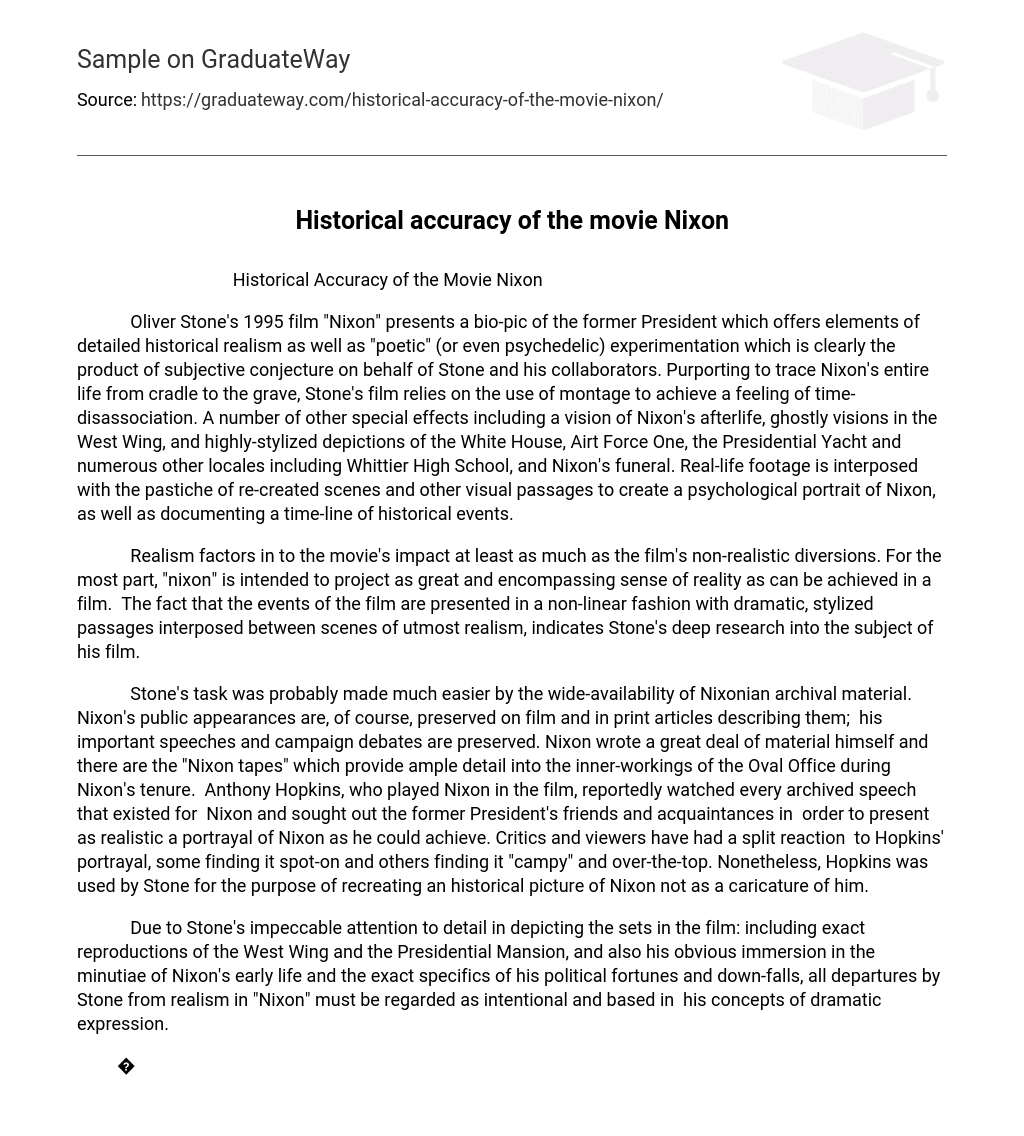Oliver Stone’s 1995 film “Nixon” presents a bio-pic of the former President which offers elements of detailed historical realism as well as “poetic” (or even psychedelic) experimentation which is clearly the product of subjective conjecture on behalf of Stone and his collaborators. Purporting to trace Nixon’s entire life from cradle to the grave, Stone’s film relies on the use of montage to achieve a feeling of time-disassociation. A number of other special effects including a vision of Nixon’s afterlife, ghostly visions in the West Wing, and highly-stylized depictions of the White House, Airt Force One, the Presidential Yacht and numerous other locales including Whittier High School, and Nixon’s funeral. Real-life footage is interposed with the pastiche of re-created scenes and other visual passages to create a psychological portrait of Nixon, as well as documenting a time-line of historical events.
Realism factors in to the movie’s impact at least as much as the film’s non-realistic diversions. For the most part, “nixon” is intended to project as great and encompassing sense of reality as can be achieved in a film. The fact that the events of the film are presented in a non-linear fashion with dramatic, stylized passages interposed between scenes of utmost realism, indicates Stone’s deep research into the subject of his film.
Stone’s task was probably made much easier by the wide-availability of Nixonian archival material. Nixon’s public appearances are, of course, preserved on film and in print articles describing them; his important speeches and campaign debates are preserved. Nixon wrote a great deal of material himself and there are the “Nixon tapes” which provide ample detail into the inner-workings of the Oval Office during Nixon’s tenure. Anthony Hopkins, who played Nixon in the film, reportedly watched every archived speech that existed for Nixon and sought out the former President’s friends and acquaintances in order to present as realistic a portrayal of Nixon as he could achieve. Critics and viewers have had a split reaction to Hopkins’ portrayal, some finding it spot-on and others finding it “campy” and over-the-top. Nonetheless, Hopkins was used by Stone for the purpose of recreating an historical picture of Nixon not as a caricature of him.
Due to Stone’s impeccable attention to detail in depicting the sets in the film: including exact reproductions of the West Wing and the Presidential Mansion, and also his obvious immersion in the minutiae of Nixon’s early life and the exact specifics of his political fortunes and down-falls, all departures by Stone from realism in “Nixon” must be regarded as intentional and based in his concepts of dramatic expression.
The more obvious departures from historical realism, such as the scene of Nixon floating off, apparently into Hell or purgatory, clutching his tapes is clearly a poetic conception, a fantasy. Whether or not Stone intended the audience to read this scene as an hallucination Nixon experienced or as a literal occurrence is beside the point; neither conception can be demonstrated to have happened historically. Similar things could be said about Stone’s portrayal of Nixon’s drug use and drinking, his erotic relationship with his wife, Pat, and his motivations for seeking and subsequently abusing the power of the Presidency.
On the whole, Stone’s film is a dramatic treatment of the former President’s biography which utilizes elements of fantasy and dramatic license to present an emotional and psychological as well as historical presentation of the film’s subject. The elements of realism that contribute to the film’s overall impact provide the backbone for the entire film, carrying Stone’s personal departures from history on a well-researched scaffolding.





